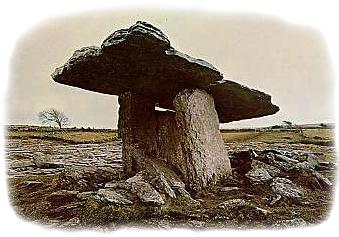The first people arrived in Ireland about
6000 BC crossing from Scotland in dug out canoes, possibly shortly
after the land bridge had been flooded. They settled on the
Antrim coast where the town of Larne is situated today, also
at Mount Sandal Co Derry.
They were essentially hunter gatherers
living on fish and other food that they gathered in the area.
Their tools included knives and scrapers made of flint. Gradually,
they moved northwards along the coast to Magilligan Point, in
County Londonderry; southwards to Dalkey Island, in County Dublin;
and inland along the river valleys.
These  early settlers
left no tangible evidence in the form of art or structures, their survival
depended on a nomadic existence following the seasonal migrations of the
species upon which they preyed, their lifestyle left little time for the
production of art. They and subsequent generations left behind their imperishable
tools, in the form of flint arrow and spear heads, and stone axes of which
in excess of twenty thousand have been discovered across Ireland. early settlers
left no tangible evidence in the form of art or structures, their survival
depended on a nomadic existence following the seasonal migrations of the
species upon which they preyed, their lifestyle left little time for the
production of art. They and subsequent generations left behind their imperishable
tools, in the form of flint arrow and spear heads, and stone axes of which
in excess of twenty thousand have been discovered across Ireland.
About 4000 BC a second wave of settlers arrived
who used domesticated animals and who knew how to make textiles and pottery.
These settlers made tools of polished stone, tilled the land and grew
cereals, it seems likely that there was little competition for land and
that the new arrivals coexisted with the earlier settlers, and in all
possibility eventually integrated with them.
They lived in small communities in round wooden
houses thatched with straw. The most striking survivals of these
people in Ireland are the megaliths  (great
stone monuments) which they erected over their dead. The simplest
type of megalith is the dolmen or portal tomb, which consists of
three or more upright stones, with a flat capstone laid across them.
An impressive dolmen is at Legananny,
in County Down. The most striking megaliths are passage graves,
of which the one at Newgrange,
in County Meath, is world-famous and was built five hundred years
before the Egyptian pyramids. (great
stone monuments) which they erected over their dead. The simplest
type of megalith is the dolmen or portal tomb, which consists of
three or more upright stones, with a flat capstone laid across them.
An impressive dolmen is at Legananny,
in County Down. The most striking megaliths are passage graves,
of which the one at Newgrange,
in County Meath, is world-famous and was built five hundred years
before the Egyptian pyramids.
Newgrange demonstrates that these early people
had an extensive knowledge of the movements of the sun and planets,
at the winter solstice the rays of the rising sun shine directly
along the entrance tunnel, proving to those watching that the sun
is returning to the northern hemisphere, enabling them to grow their
crops vital to their survival.
|

 early settlers
left no tangible evidence in the form of art or structures, their survival
depended on a nomadic existence following the seasonal migrations of the
species upon which they preyed, their lifestyle left little time for the
production of art. They and subsequent generations left behind their imperishable
tools, in the form of flint arrow and spear heads, and stone axes of which
in excess of twenty thousand have been discovered across Ireland.
early settlers
left no tangible evidence in the form of art or structures, their survival
depended on a nomadic existence following the seasonal migrations of the
species upon which they preyed, their lifestyle left little time for the
production of art. They and subsequent generations left behind their imperishable
tools, in the form of flint arrow and spear heads, and stone axes of which
in excess of twenty thousand have been discovered across Ireland. (great
stone monuments) which they erected over their dead. The simplest
type of megalith is the dolmen or portal tomb, which consists of
three or more upright stones, with a flat capstone laid across them.
An impressive dolmen is at
(great
stone monuments) which they erected over their dead. The simplest
type of megalith is the dolmen or portal tomb, which consists of
three or more upright stones, with a flat capstone laid across them.
An impressive dolmen is at